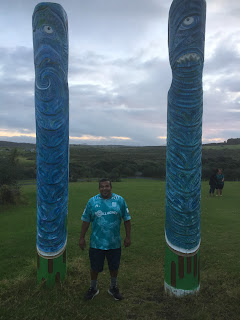Trip to Northland

While we were in Northland, we learned numerous histories of the various parts of the region. One particular history that caught my attention was the Kauri Gum Field. The history behind the Kauri Gum Field is as follows below.
From the 1840s, kauri gum was exported to Britain and America to make varnish. Later, it was used in linoleum, a floor covering. In the 19th and early 20th centuries, many people headed for the gum fields of Northland, hoping to find gum and sell it. They dug it out of the ground and found it in the swamps. Many of these areas no longer had kauri trees – they were scrublands covered in mānuka.
In the 1890s, it was getting harder to find gum in the ground. People started climbing living kauri trees to get gum. Some cut the trees, to make them bleed gum – but this often killed the trees.
The kauri gum industry continued into the 20th century. In the 1930s, cheaper materials for making varnish were invented. The price of kauri gum fell, and by the 1940s the gum industry was coming to an end.
What has once forested the most part of the Northland has deliberately disappeared. Only a few Kauri trees are left and they are completely protected.
Storekeepers bought kauri gum from diggers. It was then taken to the nearest port and shipped to Auckland, where gum merchants cleaned it, graded it, and exported it. From 1850 to 1900, kauri gum was Auckland’s main export.
At first, bled gum was seen as a ready new supply, although of poorer quality. However, it was soon clear that the practice was killing trees, and in 1905 it was banned in all state forests.
Gum was laid out at the gum tip – a cleared area, often on a rise so that it received the sun and wind. The gum’s purity was judged, a price was decided and the gum was weighed. Horse-drawn carts and large bullock teams pulled the gum on sleds to the nearest port. It was loaded onto barges, coastal cutters, and steamers, and shipped to Auckland. In the wet months, when Northland’s clay roads were boggy, transport costs often increased and supplies became more expensive.
Gum was unloaded at Auckland’s wharves and taken to the major buyers’ warehouses. It was then cleaned again and graded, ready for export. Gum was exported in boxes made from heart kauri, a high-quality timber that was often used to make furniture at the destination.
in varnish, but around 1910, overseas manufacturers began using poorer-grade gum to make linoleum. A market was created for low-grade gum, including small pieces known as gum nuts and chips, and previously worthless scrapings and dust.
New techniques were needed to recover small gum pieces from soil and swamps. Water-filled drums with screens – called hurdy-gurdies – washed away the soil and left behind the gum and bits of wood. Where large areas were dug over, pipes poured muddy water onto screens and sieves, and men agitated the mixture to wash away the soil. It was muddy, wet work. By the 1920s, new machines – basically larger oil-driven hurdy-gurdies, used by teams of men – could process a lot more raw material.The material that was left after washing – gum, stones, bits of wood and debris – was dried in the sun. Then it was winnowed by throwing it in the air. A breeze carried away the lighter pieces, leaving gum behind. Later, winnowing machines were built, along with machines to separate the gum from worthless material and to clean it. Gold mining techniques were trialed – in the late 1910s a disused Otago gold dredge worked a swamp near Awanui, but without success.
Below is the link that tells the story of our trip to Northland.
https://tome.app/jbs-a12/whakarongo-ki-te-hikoi-ki-te-rerenga-wairua-clgzkan6v00sb9r3z2t07uz4l










